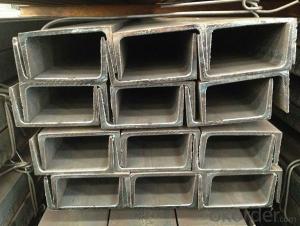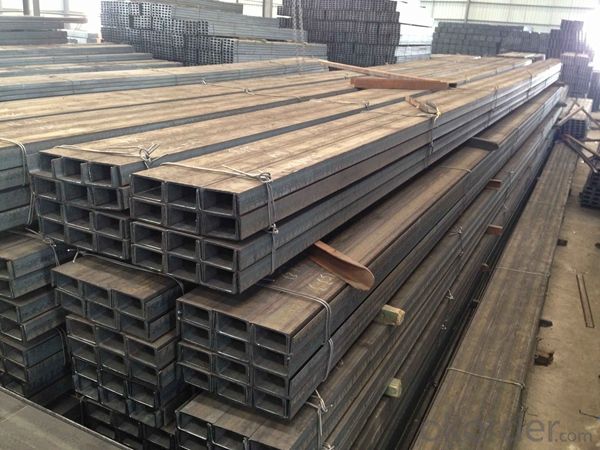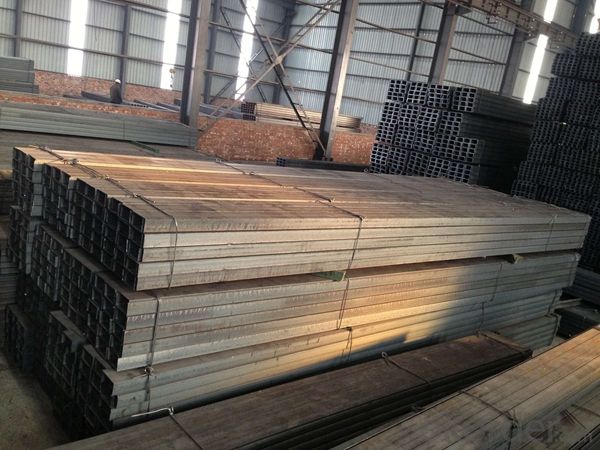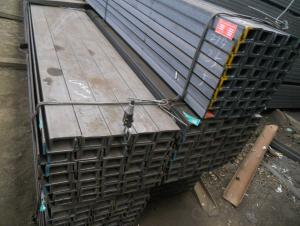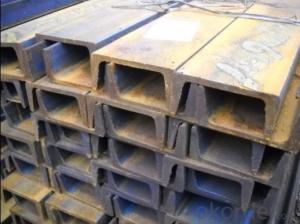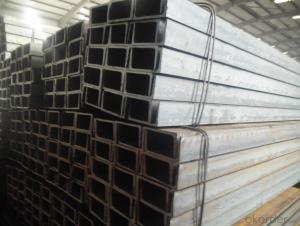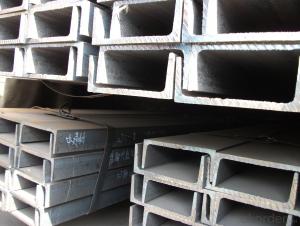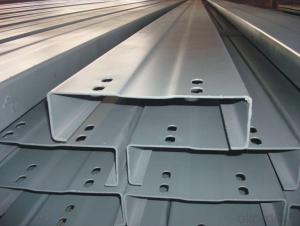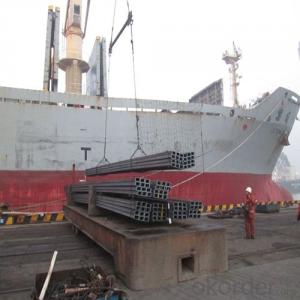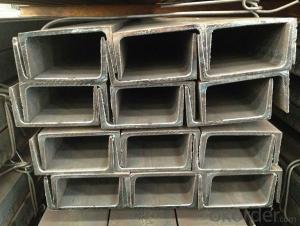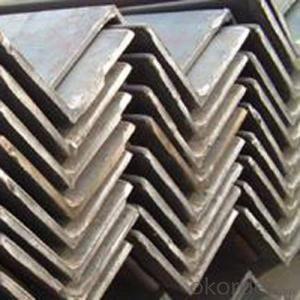Hot Rolled Steel U Channels of JIS Standard for Structures
- Loading Port:
- Guangzhou
- Payment Terms:
- TT OR LC
- Min Order Qty:
- 25 m.t.
- Supply Capability:
- 200000 m.t./month
OKorder Service Pledge
OKorder Financial Service
You Might Also Like
Product Description:
OKorder is offering Hot Rolled Steel U Channels of JIS Standard for Structures at great prices with worldwide shipping. Our supplier is a world-class manufacturer of steel, with our products utilized the world over. OKorder annually supplies products to European, North American and Asian markets. We provide quotations within 24 hours of receiving an inquiry and guarantee competitive prices.
Product Applications:
Hot Rolled Steel U Channels of JIS Standard for Structures are ideal for structural applications and general fabricating. The steel u channel can be applied to construction of warehouses, workshops, sport stadiums and car parks etc. In details, the steel u channel belongs to carbon structural steel which is applied to in the field of construction and machinery. The steel u channel is usually used for arch-itechtural structure, and they could be welded in order to support or hang a vari-ety of facilities. They are also usually used in combination with I beam. Generally,the steel u channel must possess perfect welding property, riveting property and mechanical property and so on.
Product Advantages:
Hot Rolled Steel U Channels of JIS Standard for Structures are durable, strong, and resists corrosion. And the tensile strength and yield point can satisfy the requirements of customers.
Main Product Features:
· Premium quality
· Prompt delivery & seaworthy packing (7-10 days after receiving deposit)
· Corrosion resistance
· Can be recycled and reused
· Mill test certification
· Professional Service
· Competitive pricing
Product Specifications:
Hot Rolled Steel U Channels of JIS Standard for Structures Details:
Minimum Order Quantity: 25 Tons Unit: m.t. Loading Port: Xingang Port
Supply Ability: 1000 Tons Per Day Payment Terms: TT or L/C
Product Description:
Specifications of Steel U Channel:
Standard Applied: GB Standard, EN Standard(UPN), JIS Standard
Sizes: 50mm to 300mm
Material Grade: Q235B, Q345B, S235JR, SS400, ASTM A36
As shown in the figure:
| JIS U CHANNEL | Standard h | Sectional b | Dimension s | t | Mass: Kg/m |
| (mm) | (mm) | (mm) | (mm) | ||
| 50x25 | 50 | 25 | 3.0 | 6.00 | 2.37 |
| 75X40 | 75 | 40 | 3.8 | 7.00 | 5.30 |
| 75X40 | 75 | 40 | 4.0 | 7.00 | 5.60 |
| 75X40 | 75 | 40 | 4.5 | 7.00 | 5.85 |
| 75X40 | 75 | 40 | 5.0 | 7.00 | 6.92 |
| 100X50 | 100 | 50 | 3.8 | 6.00 | 7.30 |
| 100X50 | 100 | 50 | 4.2 | 6.00 | 8.03 |
| 100X50 | 100 | 50 | 4.5 | 7.50 | 8.97 |
| 100X50 | 100 | 50 | 5.0 | 7.50 | 9.36 |
| 125X65 | 125 | 65 | 5.2 | 6.80 | 11.66 |
| 125X65 | 125 | 65 | 5.3 | 6.80 | 12.17 |
| 125X65 | 125 | 65 | 5.5 | 8.00 | 12.91 |
| 125X65 | 125 | 65 | 6.0 | 8.00 | 13.40 |
| 150x75 | 150 | 75 | 5.5 | 7.30 | 14.66 |
| 150x75 | 150 | 75 | 5.7 | 10.00 | 16.71 |
| 150x75 | 150 | 75 | 6.0 | 10.00 | 17.90 |
| 150x75 | 150 | 75 | 6.5 | 10.00 | 18.60 |
FAQ:
Q1: Why buy Hot Rolled Steel U Channels of JIS Standard for Structures from OKorder.com?
A1: All products offered byOKorder.com are carefully selected from China's most reliable manufacturing enterprises. Through its ISO certifications, OKorder.com adheres to the highest standards and a commitment to supply chain safety and customer satisfaction.
Q2: How do we guarantee the quality of Hot Rolled Steel U Channels of JIS Standard for Structures?
A2: We have established an advanced quality management system which conducts strict quality tests at every step, from raw materials to the final product. At the same time, we provide extensive follow-up service assurances as required.
Q3: Can Hot Rolled Steel U Channels of JIS Standard for Structures rust?
A3: If all the goods are newly produced, there will be no rust.
Images:
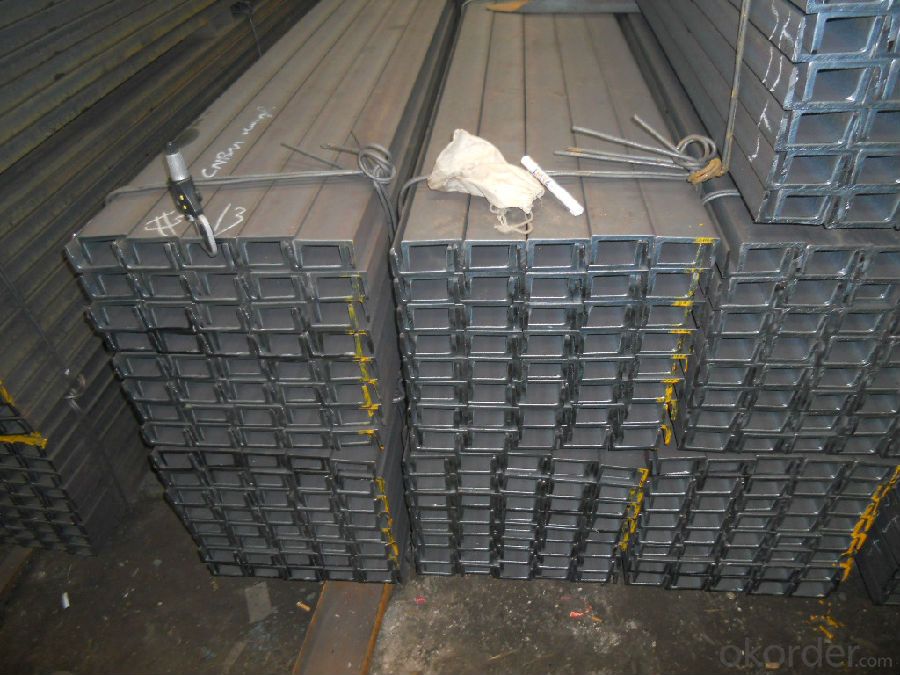
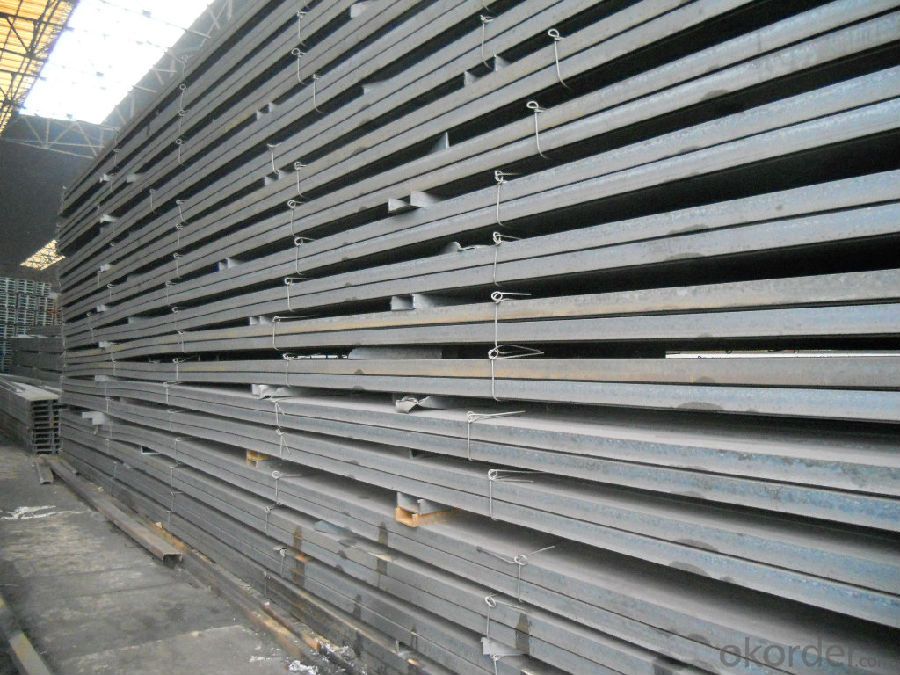
- Q: What are the different types of accessories available for steel channels?
- There are various types of accessories available for steel channels, including but not limited to, corner braces, brackets, hangers, clips, connectors, and end caps. These accessories provide additional support, stability, and versatility to the steel channels, allowing for various installation and mounting options in different applications.
- Q: How do steel channels perform under vibration?
- Steel channels generally perform well under vibration due to their high strength and stiffness. The structural integrity and durability of steel channels allow them to withstand dynamic loads and vibrations without significant deformation or failure. Steel's inherent properties, such as its high modulus of elasticity and superior damping characteristics, help to absorb and dissipate the energy generated by vibrations. Steel channels are often used in applications where vibration resistance is crucial, such as in the construction and transportation industries. They are commonly employed in the design of bridges, buildings, and industrial equipment, where they provide robust support and stability under dynamic loads and vibrations. To further enhance their performance under vibration, steel channels can be designed with additional features, such as reinforcement ribs or sandwich structures, which can increase their stiffness and damping properties. These design modifications can help to minimize the amplitude of vibrations and reduce the risk of fatigue or failure. However, it is important to note that the specific performance of steel channels under vibration can vary depending on various factors, including the design, material properties, and the magnitude and frequency of the vibrations. Proper engineering analysis and design considerations, such as selecting the appropriate steel grade and cross-sectional shape, are essential to ensure optimal performance and safety in vibration-prone environments.
- Q: How do steel channels contribute to the ease of construction?
- There are several ways in which steel channels contribute to the ease of construction. Firstly, they offer structural support and stability to various building components. These channels are specifically designed to withstand heavy loads and provide a solid framework for the overall structure, making them perfect for constructing beams, columns, and joists. In addition, steel channels are highly versatile and can be easily customized to meet specific construction requirements. They are available in various sizes and shapes, allowing for flexibility in design. This adaptability makes them suitable for a wide range of construction projects, whether it is for industrial buildings, bridges, or residential structures. Furthermore, steel channels are lightweight in comparison to other construction materials like concrete. This makes them much easier to handle and transport on construction sites, reducing the need for heavy machinery and manpower. The lightweight nature of steel channels also simplifies the construction process as a whole, minimizing the time and effort needed for installation. Moreover, steel channels are incredibly durable and resistant to various environmental factors, including corrosion, fire, and termites. This durability ensures that the structure remains stable and secure over time, reducing the need for frequent repairs or replacements. Additionally, it contributes to the overall sustainability of the construction industry by minimizing waste and promoting long-term use. In conclusion, steel channels play a crucial role in facilitating easy construction by offering structural support, design versatility, ease of handling, and durability. These qualities make them an essential component in modern construction, enhancing the overall efficiency and reliability of the construction process.
- Q: Are steel channels suitable for use in electrical applications?
- Certainly, steel channels are a fitting choice for electrical applications. Thanks to their robustness, longevity, and conductivity, steel channels frequently find use in electrical settings. They furnish a secure and steady means of affixing electrical components and wiring. Moreover, steel channels furnish superb safeguarding against physical harm, moisture, and other environmental influences. Additionally, steel channels can be conveniently tailored and adapted to suit diverse electrical setups. All in all, steel channels emerge as a dependable option for electrical applications, guaranteeing the safety and effectiveness of electrical systems.
- Q: Can steel channels be used for framing door and window openings?
- Yes, steel channels can be used for framing door and window openings. Steel channels are commonly used in construction for structural support and framing purposes. They are known for their strength and durability, making them suitable for framing openings. Steel channels provide a sturdy framework that can support the weight of the doors and windows without flexing or warping. Additionally, steel channels offer excellent resistance to corrosion and can withstand extreme weather conditions, making them a reliable choice for framing door and window openings in both residential and commercial buildings.
- Q: Can steel channels be used in the renewable energy parts manufacturing industry?
- Yes, steel channels can be used in the renewable energy parts manufacturing industry. Steel channels are a versatile and commonly used component in various industries, including renewable energy. They can be used in the manufacturing of wind turbine towers, solar panel frames, and other renewable energy infrastructure. Steel channels offer several advantages that make them suitable for the renewable energy industry. Firstly, steel channels are known for their strength and durability, which is crucial in the construction of renewable energy infrastructure that needs to withstand harsh weather conditions and provide long-term reliability. Additionally, steel channels can be easily fabricated and customized to specific dimensions, allowing for efficient manufacturing processes. This flexibility makes them ideal for creating structures that can support the weight of solar panels or wind turbines. Moreover, steel channels have excellent corrosion resistance properties, ensuring the longevity of renewable energy infrastructure even in high humidity or coastal areas. This corrosion resistance is particularly important in renewable energy applications where structures are exposed to outdoor elements for extended periods. Furthermore, steel channels are readily available and cost-effective, making them a practical choice for the renewable energy industry. Their availability in different sizes and shapes allows for easy integration into various renewable energy projects. In conclusion, steel channels can definitely be used in the renewable energy parts manufacturing industry. Their strength, durability, customization options, corrosion resistance, and cost-effectiveness make them a suitable choice for creating infrastructure in the renewable energy sector.
- Q: What are the different fabrication techniques used for steel channels?
- There are several different fabrication techniques used for steel channels. These include hot rolling, cold rolling, and extrusion. Hot rolling involves heating the steel billet and passing it through a series of rollers to shape it into the desired channel profile. Cold rolling, on the other hand, is performed at room temperature and involves passing the steel through rollers to achieve the desired channel shape. Extrusion is another technique where the steel is forced through a die to create the channel profile. Each of these techniques has its own advantages and is chosen based on factors such as the required dimensions, strength, and cost considerations.
- Q: What are the different methods for designing steel channels for seismic loads?
- There are several different methods for designing steel channels for seismic loads. These methods include: 1. Elastic Design Method: This method assumes that the structure remains linear elastic during an earthquake. It involves calculating the design forces based on the seismic coefficient and applying them to the channel using appropriate load combinations. The channel is then checked for strength and stability against these design forces. 2. Plastic Design Method: This method allows the structure to undergo plastic deformation during an earthquake. It involves determining the plastic hinges locations and calculating the design forces based on the expected plastic deformation. The channel is designed to have sufficient strength and ductility to resist these forces. 3. Yielding Design Method: This method assumes that the channel will yield but not undergo significant plastic deformation during an earthquake. It involves calculating the yield strength of the channel and designing it to have sufficient strength to resist the design forces. 4. Performance-Based Design Method: This method involves evaluating the expected performance of the structure during an earthquake. It takes into account factors such as the desired level of damage, the expected ground motion, and the importance of the structure. The channel is designed to meet the performance objectives, which may include limiting damage or ensuring occupant safety. 5. Code-Based Design Method: This method follows the guidelines and provisions specified in building codes and standards. It involves checking the channel against the specified code requirements for seismic design, such as the American Institute of Steel Construction (AISC) Seismic Provisions or the International Building Code (IBC). It is important to note that the selection of the method for designing steel channels for seismic loads depends on various factors, including the type of structure, the level of seismicity in the region, the desired performance objectives, and the applicable building codes and standards.
- Q: Can steel channels be customized to specific dimensions?
- Yes, steel channels can be customized to specific dimensions. Steel channels are versatile and can be fabricated to meet specific requirements in terms of width, height, and thickness. This customization is achieved through various manufacturing processes like cutting, bending, and welding. By altering these dimensions, steel channels can be tailored to fit specific applications and structural requirements. Whether it is for construction, machinery, or any other industry, steel channels can be customized to meet the desired dimensions and specifications.
- Q: How do steel channels contribute to the overall cost savings of a structure?
- There are multiple ways in which steel channels contribute to cost savings for a structure. Firstly, their lightweight nature and ease of handling reduce transportation costs. In comparison to materials like concrete or wood, steel channels have a high strength-to-weight ratio, making them more efficient to transport. Consequently, fewer trucks or containers are necessary for transportation, resulting in lower costs. Another aspect of cost savings with steel channels is their durability and long lifespan. Steel is highly resistant to corrosion, weathering, and pests, which means that structures built with steel channels require minimal maintenance and repairs over time. This reduces the need for expensive maintenance work and extends the structure's lifespan, leading to long-term cost savings. Furthermore, steel channels provide flexibility in design and construction. They can be easily customized and fabricated into various shapes and sizes, allowing for efficient use of materials and minimizing waste. This flexibility also contributes to faster construction times, reducing labor costs and overall project duration. Moreover, steel channels are highly recyclable. At the end of a structure's life cycle, steel channels can be easily recycled and reused in other projects. This not only reduces environmental impact but also provides cost savings by eliminating the need for new raw materials. Lastly, steel channels offer excellent structural performance, providing high strength and stability to the overall structure. This allows for the use of smaller section sizes, reducing material costs without compromising structural integrity. In conclusion, the use of steel channels in a structure results in cost savings through reduced transportation costs, low maintenance requirements, efficient use of materials, faster construction times, recyclability, and optimized structural performance. All these factors make steel channels a cost-effective choice for construction projects.
Send your message to us
Hot Rolled Steel U Channels of JIS Standard for Structures
- Loading Port:
- Guangzhou
- Payment Terms:
- TT OR LC
- Min Order Qty:
- 25 m.t.
- Supply Capability:
- 200000 m.t./month
OKorder Service Pledge
OKorder Financial Service
Similar products
Hot products
Hot Searches
Related keywords
